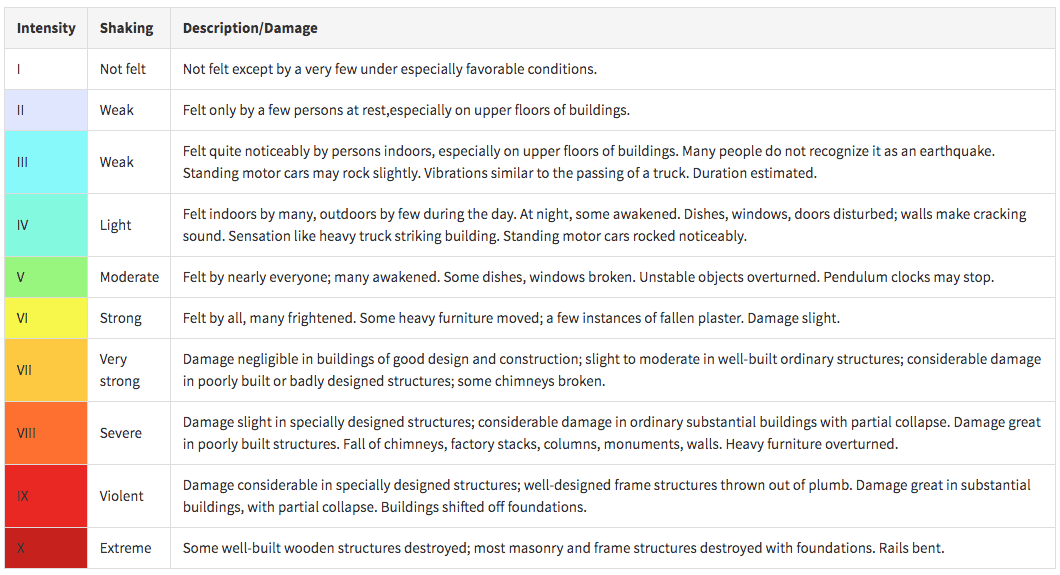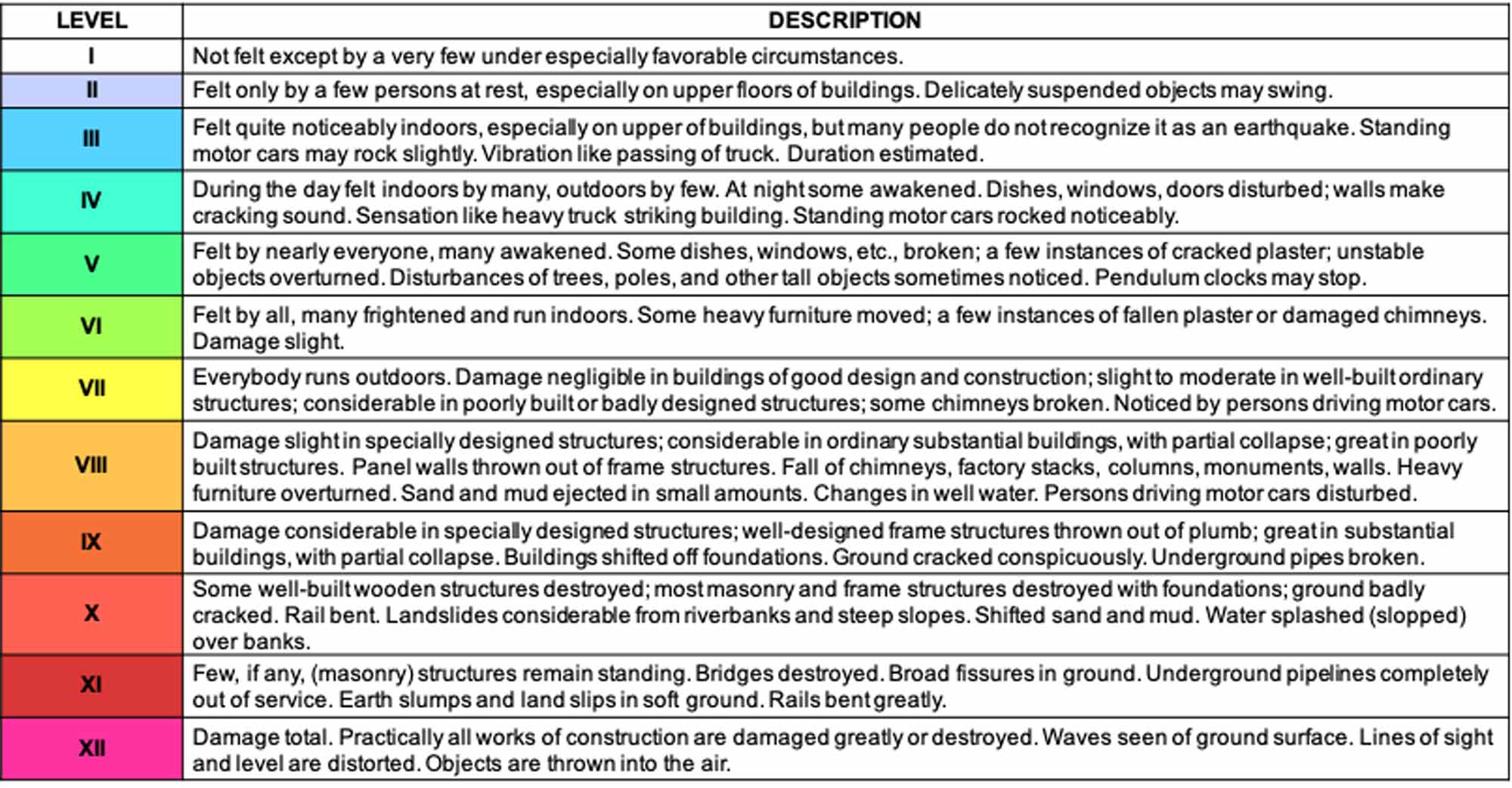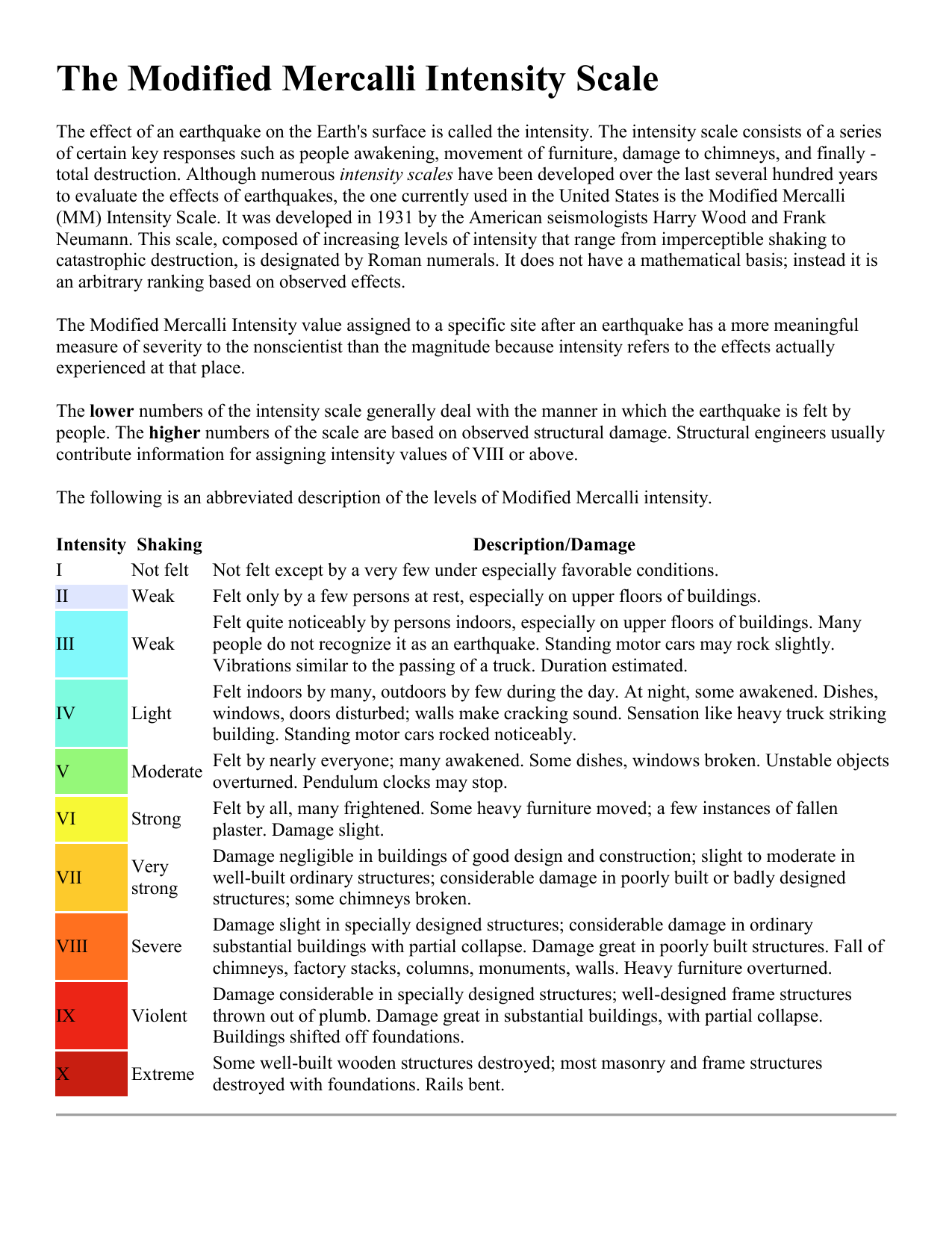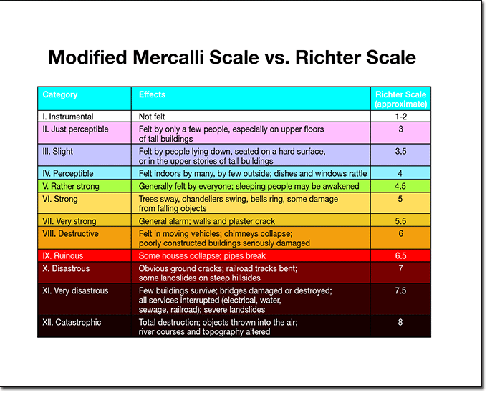Describe the Modified Mercalli Scale Explain Why It Is Useful
Not felt except rarely under especially favorable circumstances. Earthquake intensity is most often measured using the modified Mercalli scale which was invented by the Italian geologist Giuseppi Mercalli in 1902 and uses Roman numerals from I to XII.

The Modified Mercalli Intensity Mmi Scale Assigns Intensities As U S Geological Survey
Why are both of these scales important for learning about an earthquake event.

. Motion usually rapid vibration like that of a passing truck. The Mercalli intensity scale or more precisely the Modified Mercalli intensity scale is a scale to measure the intensity of earthquakes. From a scientific standpoint the magnitude scale is based on seismic records while the Mercalli is based on observable data which can be subjective.
In its range of validity each is equivalent to the Richter magnitude. Modified Mercalli Intensity Scale For additional information on statistics on percentage of uninhabitable residential units by construction type and MMI level click here. It describes the damage left by an earthquake not the actual force of the earthquake.
The intensity scale consists of a series of certain key responses such as people awakening movement of furniture damage to chimneys and finally - total destruction. Although numerous intensity scales have been developed over the last. Delicately suspended objects may swing.
Each whole number step in the magnitude scale corresponds to the release of about 31 times more energy than the amount associated with the preceding whole number value. The 12-point Modified Mercalli Intensity Scale describes how an earthquake is felt. Each seismic station in the network measures the movement of the ground at that site.
A srt file is included with the downloiad. The scale was designed to determine the extent of damage in the aftermath of an earthquake. The violence of seismic shaking varies considerably over a single affected area.
It has also been used extensively to investigate earthquakes that occurred before there were seismometers. The effect of an earthquake on the Earths surface is called the intensity. Scientists measure both the energy released in an earthquake and its damage.
In the United States we use the modified Mercalli scale which was adjusted to account for differences in buildings between Italy and southern California. The Mercalli Scale is based on observable earthquake damage. See all videos for this article.
That vibration pushes the adjoining piece of ground and causes it to vibrate and thus the energy travels out from the earthquake. The effect of an earthquake on the Earths surface is called the intensity. The seismic moment defines how much force is needed to generate the recorded waves.
The slip of one block of rock over another in an earthquake releases energy that makes the ground vibrate. The MMI scale estimates the intensity of shaking in the region around the. This is how geologists locate an earthquakes epicenter.
Modified Mercalli Scale of Earthquake Intensity. Modified Mercalli scale of earthquake intensity. Sen- sation like heavy.
Unlike with the Richter scale the Mercalli scale does not take into account energy of an earthquake directly. The Modified Mercalli Intensity Scale. The Mercalli Scale uses human observation to assess damage from an earthquake while a Richter Scale uses instruments to measure how much force an earthquake produces or the size of its waves.
MMI Value Description of Shaking Severity Summary Damage Description Used on 1995 Maps Full Description I. In 1902 Italian scientist Giuseppe Mercalli introduced a scale that measures the intensity of an earthquake based on its effects on people and structures. Rather they classify earthquakes by the effects they have and the destruction they cause.
The 1931 Modified Mercalli scale used in the United States assigns a Roman numeral in the range I - XII to each earthquake effect. Marginal and long-period effects of large earthquakes. This scale is useful in regions where there arent many instruments to measure an earthquakes streanth.
The methodology is simple. In the United States we use the Modified Mercalli MMI Scale. 12162014 The Modified Mercalli Intensity Scale httpearthquakeusgsgovlearntopicsmercalliphp 12.
Because the entire range of observed effects is not capable of simple quantitative definition the strength of the shaking is commonly. The Mercalli Scale was used earlier than the Richter Scale. The Modified Mercalli Intensity Scale.
Felt by persons at rest on upper floors or otherwise favourably placed to sense tremors. Mercalli ratings are assigned by Roman numerals. Although the Mercalli scale does not use scientific equipment to measure seismic waves it has been very useful for understanding the damage caused by large earthquakes.
Vibration like pass- ing of truck. Each is valid for a particular frequency range and type of seismic signal. The modified mercalli scale rates amount of shaking from an earthquake.
It measures the effects of an earthquake at a given location distinguished from the earthquakes inherent force or strength as measured by seismic magnitude scales. The Modified Mercalli intensity scale developed from Giuseppe Mercallis Mercalli intensity scale of 1902 is a seismic intensity scale used for measuring the intensity of shaking produced by an earthquake. That information is plugged into the moment magnitude scale to give us the amount of energy that is released during an earthquake.
CllM Intensity VI Vil Vill Peoples Reaction Not felt Felt by a few. Duration can be estimated. The scale was expanded to accommodate 12 degrees of intensity by Adolfo Cancani in 1902.
Sometimes not recognized to be an. Another important scale used by earthquake scientists is the Modified Mercalli Intensity MMI scale. Giuseppe Mercalli an Italian volcanologist introduced the Mercalli Intensity Scale in 1885.
A modified version of his scale is still in use today. The Mercalli Scale. Felt indoors only by a few persons especially on upper floors of buildings.
Should people be able to live in an area where. Felt indoors by several persons. The Richter scale measures the magnitude of earthquakes and the Mercalli scale measures their intensity.
To help distinguish it from magnitude scales the MMI scale uses roman numerals. Thus the magnitude scale is considered scientifically more objective and therefore more accurate. At each location assign a numeral to describe the earthquake effect Contour the zones of similar effect The earthquake is assumed to have occurred near the region of maximum intensity.
If this table is garbled try the plain text version. Use appropriate media player to utilize captioning. Describe the difference between the magnitude Richter Scale and intensity Modified Mercalli Intensity Scale of an earthquake.
Vibrations are similar to those caused by the passing of light trucks. Earthquakes are recorded by a seismographic network. The intensity scale consists of a series of certain key responses such as people.
In particular for very large earthquakes. Why do you think earthquakes are so difficult to predict. Because of the limitations of all three magnitude scales ML Mb and Ms a new more uniformly applicable extension of the magnitude scale known as moment magnitude or Mw was developed.

Earthquake Science The Modified Mercalli Intensity Scale Mmi

Earthquake Part 3 Science Fest


0 Response to "Describe the Modified Mercalli Scale Explain Why It Is Useful"
Post a Comment